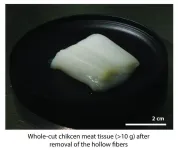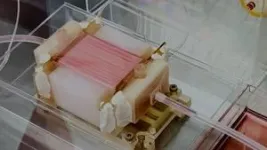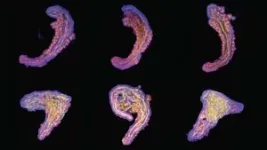(Press-News.org) A bioreactor that mimics a circulatory system can deliver nutrients and oxygen to artificial tissue, enabling the production of over 10 grams of chicken muscle for cultured meat applications. These results are publishing in the Cell Press journal Trends in Biotechnology on April 16.
“Our study presents a scalable, top-down strategy for producing whole-cut cultured meat using a perfusable hollow fiber bioreactor,” says senior author Shoji Takeuchi of The University of Tokyo. “This system enables cell distribution, alignment, contractility, and improved food-related properties. It offers a practical alternative to vascular-based methods and may impact not only food production but also regenerative medicine, drug testing, and biohybrid robotics.”
A significant obstacle to the reconstruction of large-scale tissues is the creation of well-distributed vascular networks because diffusion alone cannot sustain cells across considerable distances. The thickness of tissues without an integrated circulatory system has generally been limited to less than 1 mm, making it challenging to produce centimeter-scale or larger tissues with densely packed cells.
“We're using semipermeable hollow fibers, which mimic blood vessels in their ability to deliver nutrients to the tissues,” Takeuchi says. “These fibers are already commonly used in household water filters and dialysis machines for patients with kidney disease. It's exciting to discover that these tiny fibers can also effectively help create artificial tissues and, possibly, whole organs in the future.”
The authors demonstrated the biofabrication of centimeter-scale chicken skeletal muscle tissues using a Hollow Fiber Bioreactor (HFB) consisting of an array of 50 hollow fibers. In addition, they implemented a robot-assisted assembly system for the fabrication of a 1,125-fiber HFB and produced whole-cut chicken meat weighing more than 10 g using chicken fibroblast cells, which make up connective tissue.
“Cultured meat offers a sustainable, ethical alternative to conventional meat,” Takeuchi says. “However, replicating the texture and taste of whole-cut meat remains difficult. Our technology enables the production of structured meat with improved texture and flavor, potentially accelerating its commercial viability. Beyond food, this platform may also impact regenerative medicine and soft robotics.”
According to Takeuchi, additional challenges for future research include determining the long-term effects of perfusion on tissue quality, adapting the technology for organ fabrication and biohybrid robotics, and further improving the mechanical properties and structural integrity of the tissue to better mimic the characteristics of natural muscle tissue.
“We overcame the challenge of achieving perfusion across thick tissues by arranging hollow fibers with microscale precision,” Takeuchi says. “Remaining challenges include improving oxygen delivery in larger tissues, automating fiber removal, and transitioning to food-safe materials. Solutions may include use of artificial oxygen carriers to mimic red blood cells, bundle-removal mechanisms that efficiently remove fibers in a single operation, and edible or recyclable hollow fibers.”
###
The authors have patent applications (PCT/JP2022/047671 and WO2023120710A1) related to this work.
Trends in Biotechnology (@TrendsinBiotech) is a multi-disciplinary Cell Press journal publishing original research and reviews on exciting developments in biotechnology, with the option to publish open access. This journal is a leading global platform for discussion of significant and transformative concepts across applied life sciences that examine bio-based solutions to real-world problems. Trends in Biotechnology provides cutting-edge research that breaks new ground and reviews that provide insights into the future direction of the field, giving the reader a novel point of view. Visit https://www.cell.com/trends/biotechnology. To receive Cell Press media alerts, contact press@cell.com.
Trends in Biotechnology, Nie et al. “Scalable tissue biofabrication via perfusable hollow fiber arrays for cultured meat applications” http://cell.com/trends/biotechnology/fulltext/S0167-7799(25)00085-X
END
Physicists in the Harvard John A. Paulson School of Engineering and Applied Sciences (SEAS) have created a compact laser that emits extremely bright, short pulses of light in a useful but difficult-to-achieve wavelength range, packing the performance of larger photonic devices onto a single chip.
Published in Nature, the research is the first demonstration of an on-chip, picosecond, mid-infrared laser pulse generator that requires no external components to operate. The device can make what’s called an optical frequency comb, a spectrum of light consisting of equally spaced frequency lines (like a comb), used today in precision measurements. ...
About The Study: This analysis found that past-month binge drinking among young adult females in 2021-2023 was higher than males, reversing 2017-2019 patterns, whereas males in other age groups continued to binge and heavy drink at higher rates. These findings may be due to more rapid decreases in binge drinking over time among young adult males relative to females, or to plateauing or increases in binge drinking among females. Further investigation using other nationally representative surveys is needed to elucidate these explanations.
Corresponding Author: To contact the corresponding author, Bryant Shuey, MD, MPH, email bryant.shuey@pitt.edu.
To ...
Beneath Yellowstone lies a magma reservoir, pulsing with molten and superheated rock and exsolved gases. Scientists have long known about the chamber’s existence, but have yet to precisely locate its uppermost boundary and characterize the contents of the chamber closest to the surface—information crucial for understanding the potential perils this volcanic feature poses.
That changed this week with new research by seismologists from the University of Utah and the University of New Mexico (UNM) who used hundreds of portable seismometers and a mechanical vibration source to render 2D seismic reflection images of the ground beneath Yellowstone’s caldera.
Using ...
A team of scientists led by Prof. LIU Zhaoping at the Ningbo Institute of Materials Technology and Engineering (NIMTE) of the Chinese Academy of Sciences, in collaboration with researchers from the University of Chicago and other institutions, has developed zero thermal expansion (ZTE) materials. This innovation has achieved nearly 100% voltage recovery in aging lithium-ion batteries (LIBs), as detailed in a study published in Nature.
LIBs have become increasingly essential in the markets for electric vehicles and aircraft. Lithium-rich layered oxide cathode materials can deliver record capacities exceeding 300 mAh/g, thanks to revolutionary oxygen-redox (OR) ...
New research from Barcelona and Dresden: Glycolysis — the process of converting sugar into energy — plays a key role in early development.
More than fuel: Glycolysis doesn’t just power cells — it helps steer them toward specific tissue types at critical moments in development.
Better embryo models: Stem-cell–based embryo models that rely on glycolysis form structures more similar to natural embryos.
Predict and control development in a dish: These findings improve our ability to predict and control how stem-cell-based embryo models will develop, ...
About The Study: Across multinational cohorts, a noise-adapted artificial intelligence (AI)-electrocardiogram (ECG) model estimated heart failure risk using lead I ECGs, suggesting a potential heart failure risk-stratification strategy requiring prospective study using wearable and portable ECG devices.
Corresponding Author: To contact the corresponding author, Rohan Khera, MD, MS, email rohan.khera@yale.edu.
To access the embargoed study: Visit our For The Media website at this link https://media.jamanetwork.com/
(doi:10.1001/jamacardio.2025.0492)
Editor’s ...
About The Study: In this randomized clinical trial, 2 hours of mother-neonate skin-to-skin contact (SSC) in the delivery room did not enhance neurodevelopmental outcomes at 2 to 3 years of age. However, the SSC group demonstrated improved breastfeeding practices up to 12 months compared with standard care, suggesting that the feasible and low-cost SSC intervention should be encouraged in clinical practice.
Corresponding Author: To contact the corresponding author, Laila Kristoffersen, RN, PhD, email laila.kristoffersen@ntnu.no.
To ...
Scientists have designed a ‘cosmic radio’ detector which could discover dark matter in 15 years.
Published today in Nature, scientists at King’s College London, Harvard University, UC Berkley and others have shared the foundation of what they believe will be the most accurate dark matter detector to date.
Dark matter is the unobservable form of matter could make up as much as 85% of mass in the Universe, but scientists are not sure exactly what it is.
Axions are one of the leading ...
As we age, blood stem cells, the essential source of new blood cells in the body, can accumulate genetic mutations. These mutations can give the cells a growth advantage, laying the foundation for developing serious health conditions. Now, scientists at The Jackson Laboratory (JAX) have not only discovered the mechanism that fuels their unchecked growth but have also found a way to stop it.
Led by Jennifer Trowbridge, professor and The Dattels Family Chair at JAX, the study reported today in the April 16 issue of Nature Communications reveals that a common aging-associated mutation in the gene Dnmt3a boosts the power-generating function of mitochondria ...
One reason why our livers excel at clearing waste from our blood system is that the organ functions according to three key “zones” that perform specific major tasks. So, if scientists hope to create self-growing patches of liver organoid tissue that could help repair damaged organs, it’s important that the lab-grown tissue faithfully reproduce such zones.
In a groundbreaking paper published April 16, 2025, in the prestigious journal Nature, a team of organoid medicine experts at Cincinnati Children’s reports achieving just such a milestone – made from human stem cells. When these humanized organoids were transplanted into rodents whose own liver-bile duct system ...








